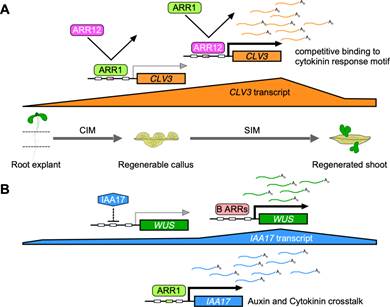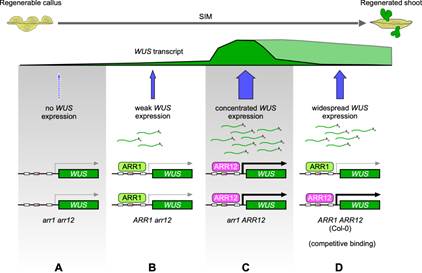Recently, a research article entitled "The Type-B Cytokinin Response Regulator ARR1 Inhibits Shoot Regeneration in an ARR12-Dependent Manner in Arabidopsis" was published on the top journal The Plant Cell. Dr. Liu Zhenhua, Dr. Dai Xuehuan, and Dr. Li Juan are co-first authors; Prof. Xiang Fengning is the corresponding author. The key laboratory of plant development and environmental adaptation biology and the School of Life Sciences are the first corresponding institutions.
In contrast to most animal cells, plant cells typically maintain totipotency, allowing regeneration of a wide variety of explant types into whole plants through the appropriate choice of in vitro culture conditions. Exogenous cytokinin is critical for in vitro shoot regeneration and media with a high cytokinin/auxin ratio are required for shoot regeneration. Some type-B ARRs (e.g. ARR1 and ARR12) promote shoot regeneration by directly activating WUSCHEL(WUS) expression. However, the functions of individual type-B ARRs in shoot regeneration are not fully understood, and the repression of shoot regeneration by type-B ARRs has not been previously reported.

ARR1 inhibits shoot regeneration through the indirect repression of CLV3 and the direct activation of IAA17

ARR1 inhibits shoot regeneration by competing with ARR12 for binding to theWUSpromoter
Here, the research show that ARR12 is a central enhancer of callus formation and shoot regeneration, whereas ARR1 is a strong inhibitor of this processthat counteracts the positive effect of ARR12.ARR1 indirectly represses CLAVATA3 and WUS expressionin an ARR12-dependent manner via competing with ARR12 for binding to their promoters, which contributes to its ARR12-dependent inhibitory effect oncallus formationand shoot regeneration. In parallel, ARR1 inhibits shoot regeneration through transcriptional activation of INDOLE-3-ACETIC ACID INDUCIBLE17(IAA17), an auxin response repressor gene, and the consequent indirect repression of WUS expression. Thus, type-B ARRs have diverse effects oncallus formationand shoot regeneration. Our study reveals novel molecular pathways linking cytokinin signaling, the CLV3 regulator, and auxin signaling, and sheds light on the mechanism underlying cytokinin-regulated shoot regeneration.
This research was financially supported by the National Key Research and Development Program of China, the Major Program of Shandong Province Natural Science Foundation, the National Transgenic Project of China, National Natural Science Foundation,etc. Prof. Xiang's group has been committed to the study of the mechanism underlying Arabidopsis shoot regeneration for years. They have identified several functional genes and miRNAs involved in shoot regeneration, which are conducive to the understanding of the mechanism of plant cell totipotency.
Written by: Liu Zhenhua
Edited by: Xie Tingting